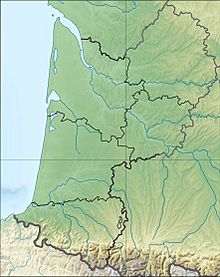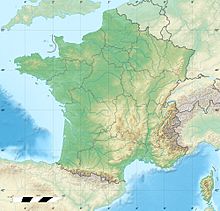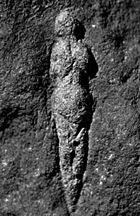Abri Pataud facts for kids
|
Abri Pataud
|
|

Abri Pataud
|
|
| Alternative name | Pataud Shelter |
|---|---|
| Location | near Eyzies-de-Tayac, |
| Region | Dordogne, France |
| Coordinates | 44°56′13″N 1°0′45″E / 44.93694°N 1.01250°E |
| History | |
| Cultures | Magdalenian |
| Site notes | |
| Excavation dates | 1953, |
| Archaeologists | Hallam L. Movius |
L'Abri Pataud, or the Pataud Shelter in English, is a prehistoric site found in the middle of the village Les Eyzies-de-Tayac-Sireuil in Dordogne, Aquitaine, southwestern France. The site includes human remains, stone tools, and early cultural artifacts made during the Upper Paleolithic, between approximately 47,000 and 17,000 years ago.
Site overview
The stratigraphic sequence at the site includes remains from the Upper Paleolithic, particularly from the Aurignacian (47,000 to 27,000 BP), the Gravettian (32,000 to 22,000 BP), and lastly from the Solutrean (22,000 to 17,000 BP). Remains include human bones, tools, and cave paintings.
The French government classified the site as an historical monument by decree on 25 June 1930, and additional shelters located nearby under the cliff further protected as of May 9, 1958. The site became the property of the museum of natural history in 1957 at the initiative of Hallam L. Movius, who had directed excavations since 1953. Movius continued to direct investigations between 1958 and 1964, aided by a team from the museum.
The results of the excavations were compiled by Harvey M. Bricker, on the basis of American hypotheses regarding the site's origins. A finer reading of the stratigraphy of the site may not have been published; continuing work will help elucidate the evolution of stone tool use at the shelters themselves, and their relationship to other sites in the region.
The Venus of l'Abri Pataud
In 1958, a small carved female figure was found on a stone about 20 cm (7.9 in) tall, likely dating to approximately 21,000 years BP. According to Hallam Movius, the figure represents a comparatively young woman, "more slender and gracile than is normally the case," roughly carved, and with contours suggesting pregnancy. Movius wrote that the despite "disharmonic features, the overall proportions of the figure are both pleasing and, at first glance, symmetrical." Movius continued, "from a stylistic point of view, this figure has been rendered in the finest tradition of Upper Paleolithic art as represented by the well-known series of carvings and statuettes, collectively known as Venuses…"
The figure was found following a violent storm, making its origin within the shelter difficult to know exactly.
Public access
Since 1990 the site has allowed visitors from the public. Under the direction of Henry de Lumley, assisted by Brigitte Delluc, a museum was established allowing partial views of excavations.
See also
- Upper Paleolithic
- Hallam L. Movius
- Les Eyzies-de-Tayac-Sireuil





